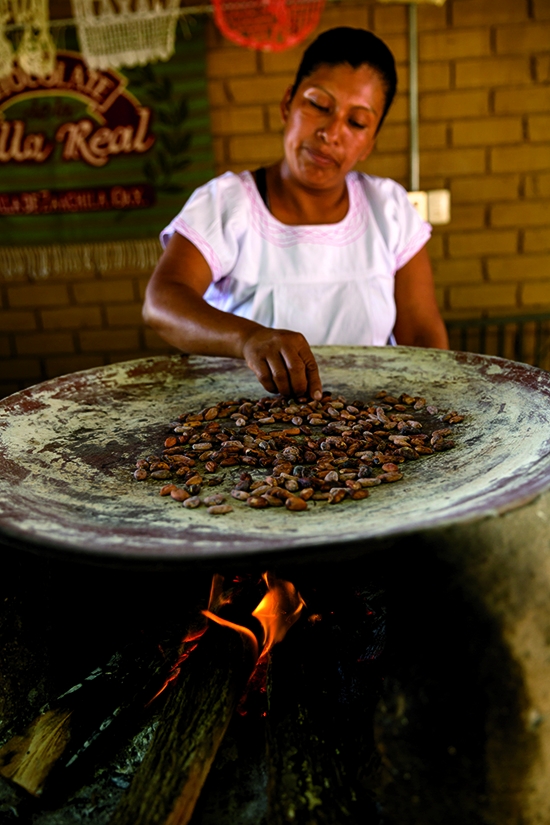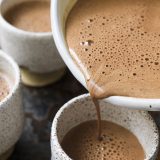The last thing I wanted as I stepped onto the sunlit courtyard of Chocolate de la Villa Real in the midday Mexican heat was a cup of cocoa. I’d spent the morning sweating, wending my way through overflowing displays of terra cotta pots, dried herbs, raw meat and massive bowls of frothy beverages in a market in Zaachila, a small town outside Oaxaca City. The trip was sandwiched by long, hot car rides made longer by a teacher’s strike that had shut down the area’s major highways. I was parched. I yearned for cold agua fresca, a frosty beer, even a cocktail.
But hot chocolate was precisely what brought me to this factory, off a quiet Zaachila backstreet. It promised to be different from the cocoa I knew—thick, sweet, all too easy to scald and quick to form an unappealing film if left to sit. But this hot chocolate would be different—based on water, the way it was made before Europeans introduced cows and dairy to Mexico. And it wouldn’t involve a saucepan or a stovetop—in fact, it’s done outdoors, in a ritualistic process reserved for weddings, funerals and Day of the Dead.
My thirst receded as I watched Berenice, a nimble woman with strong hands, prepare the hot chocolate. It starts with whole cacao beans and a comal—a thin clay griddle set over a wood fire. Berenice spreads a pile of stony beans over the comal and lets them cook, turning them with bare fingers. As their skins grow glossy, a buttery aroma perfumes the air. Soon, they start popping; the smell takes on a roasted note—telltale cues they’re ready.
Now we move to another ancient cooking tool, the metate: a curved stone slab elevated by two feet, coupled with a stone rolling pin. Berenice sets hot coals under hers to make the arduous task more expedient. (A woman who cannot use the metate, a local axiom goes, isn’t fit to marry.) Before we begin, we peel the papery skins off the beans. I pop one into my mouth and am shocked—sour, chalky, bitter, a striking contrast to their scent.
Berenice scatters beans over the metate’s surface, bends over the slab with pin in hand, then rolls backward and presses forward, scraping the stones together, pulverizing the beans to a thick paste. It looks crumbly and slightly wet, like raw nut butter. I take a taste—all astringency.
She adds cinnamon bark, pecans and toasted almonds. This adds richness, and as Berenice crushes them into the chocolate, the paste grows more oily. Next, white sugar. The additions, explains my translator, reflect European influences. When Spaniards arrived here, they found the taste of unadulterated cocoa too intense, so they used sugar, vanilla and milk to smooth it out. Mexican cooks later added Old World ingredients like cinnamon and nuts.
Finally, the paste is done. “When it shines like a mirror, it’s ready,” my translator says. Berenice transfers it to a pitcher, adds hot water, then uses a molinillo—a whisk of sorts—to blend the two. I take a sip: The sugar has tempered the sourness and brought out the butteriness. The bitterness remains but pleasantly so. Just a little sweetness marries the two sides of the cocoa. The spice and nuts add complexity. And somehow, even in this heat, the drink hits the spot.

At Milk Street, we loved that the intensely bittersweet chocolate wasn’t diluted (or complicated) by dairy, but we had to adjust the process. The comal, metate and molinillo were out—as were cacao beans. While cacao nibs were a close match, they can be a chore to find. The most accessible substitute was 100 percent cacao chocolate. Brown sugar gave the drink caramel-like sweetness.
As for the process, we found a one-step solution: the blender. Combining chopped chocolate with hot water softened it so we could puree in sugar, cinnamon and creamy almond butter, which added smooth nuttiness and body. The result was powerfully chocolatey cocoa with the right richness and the deep, bittersweet flavor of the one I had in Oaxaca—with no risk of boiling over.




